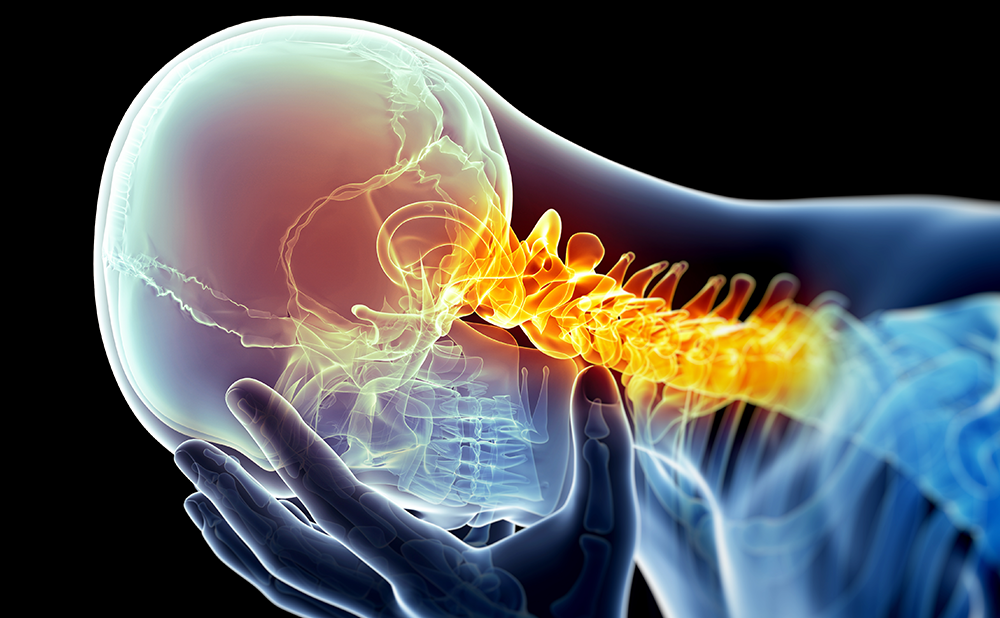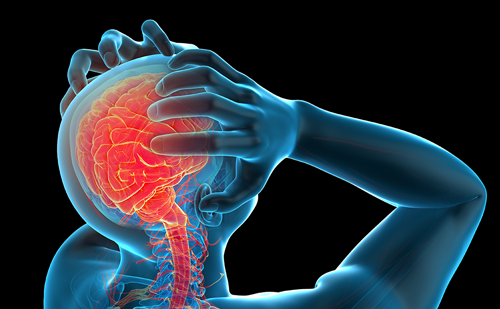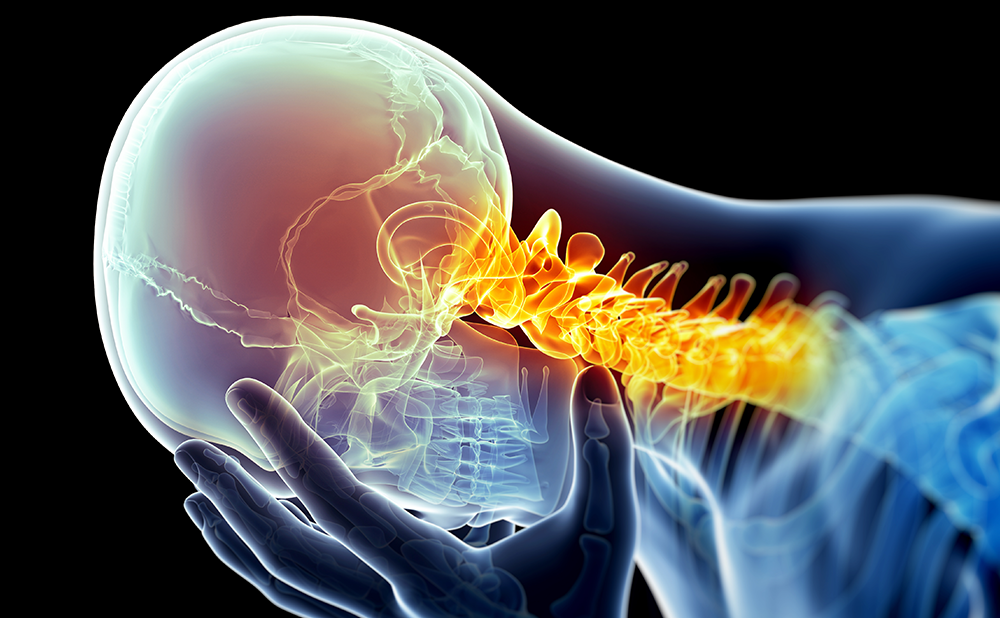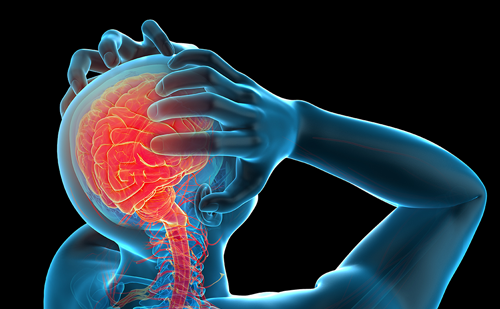Migraine is one of the most prevalent neurological illnesses occurring in approximately 10 % of the US population, with a total prevalence of up to 29.6 % if probable migraine is also considered.1,2 The disorder manifests as episodic pain that is disabling in 50–75 % of patients with migraine.2 With nearly one in four households affected by migraine,2 the disease results in direct and indirect costs of about $23 billion per year.3,4 Despite the disabling nature of migraine, 50 % of patients with migraine go undiagnosed.5 The diagnosis of migraine is made almost exclusively by history. Secondary headaches must be excluded when the neurologic exam is abnormal or headache is of new onset or has atypical features. The American Migraine Prevalence and Prevention study reported that acute migraine-specific treatment was only used by 19 % of patients with migraine. The lack of effective treatment and the limited uptake means there is a significant clinical unmet need for treatment and patient education.6
Migraine Diagnosis
The typical features and criteria of migraine (see Table 1) have been established by the International Headache Society (IHS) and are the basis for the study and diagnosis of migraine.7 A self-administered migraine screener, ID Migraine, has been validated for use in the primary care setting, and has reported sensitivity of 81 %, specificity of 75 %, and positive predictive value of 93 %.8 If a patient expresses at least two of the following three features the likelihood of migraine is high: disability, nausea, and sensitivity to light.
When migraine attacks are inadequately treated, it is common for headaches to increase in frequency leading to a process of ‘chronification’.9 This process occurs in approximately 3 % of patients with episodic migraine each year.10 When headaches occur more than 15 days per month for more than three months these patients are classified as having chronic migraine.7
Migraine Pathophysiology
The progression from episodic migraine to chronic migraine has been explained through a combination of experimental paradigms based on the current understanding of migraine pathophysiology. Although the pain from migraine is caused by inflammation of meningeal vessels and pericranial structures, the event originates from an electrical instability within cortical and subcortical neurons. The cortical event leads to the symptoms of migraine aura which manifests in 15–20 % of patients with migraine and the subcortical event leads to activation within the trigeminal nucleus caudalis in the pons and descending spinal trigeminal tracts.11,12, Sensation from the head and neck is then relayed orthodromically to cortical pain and sensory processing areas. When the trigeminal system is activated during the migraine event it triggers a reflex that sends electrical signals antidromically to the periphery,13 known as the trigeminovascular response.14 Peripheral nerve endings then release an ‘inflammatory soup’ of substances including prostaglandins, histamine, cytokines, substance P, calcitonin gene-related peptide, and bradykinin, which results in inflammation and swelling of peripheral tissues(meningeal, blood vessels, muscle, skin).15 Migraine pain is a result of the sensitization of the peripheral tissues leading to allodynia, resulting from a non-painful stimulus. Once the process begins, the pain derived from the inflammation is transmitted back to trigeminal neurons where the loop is completed and reinforces the trigeminal-vascular response, enhancing the pain event and making it more difficult to treat.16
In addition to the peripheral release of prostaglandins, the cortical event in migraine, cortical spreading depression, not only results in a wave of depolarization with the cortex but also prostaglandin release centrally.17,18 The use of prostaglandin-inhibiting medication that acts via inhibition of cyclo-oxygenase (COX) can suppress cortical spreading depression. COX- 1/COX-2 inhibitors exhibit this effect but aspirin and COX-2 inhibitors alone do not.19,20 An effort was made by Sarchielli et al. to establish a link between the animal evidence and clinical migraine. Five patients with migraine were assessed with assays for neurokinin A (NKA), prostaglandin E2, and nitrites after onset of migraine attacks at 30 minutes, one hour, two hours, four hours, and six-hours. Maximum prostaglandin levels were achieved two hours after an attack with sustained elevation through the sixth hour time point. The levels were assessed again after the end of the attack, with prostaglandin levels falling below those recorded 30 minutes after headache onset. Levels of nitrites, NKA and the intracellular messengerscyclic guanosine monophosphate (cGMP), calcitonin gene-related peptide (CGRP) peaked at the first hour then gradually decreased to levels lower than those at headache onset. These data suggest a relationship between the activation of the L-arginine/nitric oxide pathway, the release of vasoactive peptides from trigeminal endings, and a late rise in the synthesis of prostanoids which may be involved in maintaining the headache phase.21
Acute Migraine Treatment
For several years, treatment of acute migraine has been based on a stratified approach utilizing more-‘specific’ therapy targeted to migraine pathophysiology depending on the severity of headache. This approach has been validated as not only more effective for headache treatment but more cost effective as well. Treatment with analgesics such as acetaminophen or the use of over the counter non-steroidal anti-inflammatory drugs (NSAIDs) are recommended for patients with only mild headache. For patients with moderate to severe headaches, approved therapeutic options include selective serotonin receptor (5-HT1) agonists (triptans),22 Cambia® (diclofenac potassium for oral solution) and ergot alkaloids. The latter are non-selective 5-HT1 agonists that have a wider spectrum of receptor affinities outside of the 5-HT1 system, including dopamine receptors.
Although triptans, ergot alkaloids and Cambia have been approved by the FDA as effective for migraine treatment, more than 25 % of patients with migraine are dissatisfied with their current treatment23 and nearly 80 % could be willing to try an alternative.24 Triptans are generally considered superior to ergot alkaloids from both an efficacy and side-effect perspective.25 However, intolerance of side effects (blood vessel constriction, chest pain/pressure/tightness, esophageal spasm, dizziness, fatigue, nausea, light headedness, etc.) is also a major source ofdissatisfaction with triptans, leading to the need for a viable alternative.26 It is for this reason that certain NSAIDs, such as Cambia, have been re-examined as a potential treatment alternative for acute migraine.
Diclofenac has a long history of use in a variety of forms.27 As a member of the NSAID class, it not only suppresses peripheral inflammation in migraine but also acts centrally to limit central sensitization.28,29 In patients with fewer than 10 migraines per month, use of NSAIDs has been shown to prevent progression from episodic migraine to chronic migraine.30 Data from available placebo-controlled clinical trials indicate that diclofenac potassium is as effective as triptans and ergot-based medication, has a faster onset, and is better tolerated.31
Cambia® in the Treatment of Acute Migraine
Cambia is a novel, patented formulation of diclofenac potassium that is the only prescription strength NSAID approved and indicated by the FDA for the acute treatment of migraine. It offers several advantages over conventional diclofenac tablets in that it is a 50 mg packet of powder that is buffered and used in solution to improve peak absorption of the medication.32 Consequently, when compared with oral diclofenac pills, peak absorption for Cambia occurs within 15 minutes in contrast to pills or other forms of non-buffered diclofenac for which peak absorption occurs around 60 minutes.33 Only injectable pharmacotherapies are faster. This feature of rapid peak absorption is critical in the treatment of migraine because it has been shown that early intervention may reduce central sensitization in rat models,16 leading to supportive early treatment research paradigms in humans, aimed at improving the acute treatment of migraine.34,35 Furthermore, Cambia’s buffered oral solution provides efficacy in such cases when the possibility of gastroparesis is of concern.
There have been two large pivotal multicenter trials of Cambia in the acute treatment of migraine—one in Europe27 (see Figures 1 and 2 and Table 2), and one in the US36 (International migraine pain assessment clinical trial [IMPACT] study) (see Figures 3 and 4). The European trial was performed as a randomized, double-blind, double-dummy, cross-over study in 328 patients with migraine pain, treating 888 attacks. All patients in the trial reported pre-treatment headache intensity as moderate (approximately 50 %) and severe (approximately 40 %). The primary endpoint of being pain-free two hours post dose was achieved in 24.7 % of patients compared with diclofenac 50 mg pills (18.5 %) and placebo (11.7 %) (p<0.0001). Patients treated with Cambia had 46 % pain relief within two hours compared with diclofenac 50 mg pills (41 % p<0.0035) and placebo (24 % p<0.0001). Benefit began within 15 minutes of use compared with 60 minutes for diclofenac tablets. It was notable that 22.1 % of patients who were pain-free after using Cambia remained pain-free at 24 hours as opposed to 15.3 % with diclofenac and 9.4 % with placebo. Cambia and diclofenac tablets were both superior to placebo for two hour reduction of nausea, photophobia, and phonophobia.27
The US IMPACT trial was a randomized, double-blind, parallel-group, placebo-controlled study conducted in 23 US centers, involving 690 participants. Adult sufferers treated a moderate to severe attack with 50 mg Cambia (n=343) or placebo (n=347), similar to the European trial. Cambia resulted in a two-hour pain-free response (25 versus 10 % forplacebo, p<0.001). The differences between Cambia and placebo were apparent at 30 minutes post dose with continued significant differencethroughout all measured time points. Interestingly, 19 % of those receiving Cambia versus 7.2 % from the placebo group remained pain-free at 24 hours (p<0.001), and Cambia was again superior to placebo with patients being free from nausea, photophobia, and phonophobia.36
Side effects of Cambia in both studies were similar to placebo with overall incidence of all adverse events of about 6–7 %27 with the greatest side-effect reported for Cambia being nausea of 4.6 % compared with placebo of 3.5 %.36
Typically, long-term treatments involve medications used for acute attacks combined with preventative medications. Successful long-term treatment requires knowledge of potential interactions and contraindications. Concerns of serious adverse events have frequently resulted in insufficient treatment of the disorder.
Current long-term preventative treatments in migraine include cardiovascular drugs (propranolol and verapamil), beta blockers, calcium channel blockers, antidepressants (amitriptyline and protriptyline), anti-seizure drugs (topiramate, gabapentin, and valproate), selective serotonin re-uptake inhibitors, serotonin antagonists, and recently, botulinum toxin type A.37–39
A Clinician’s Perspective on Cambia® Use
From the point of view of a practitioner working in a multidisciplinary headache clinic where patients range from those with episodic migraine to chronic migraine, as well as those with other forms of primary and secondary headaches, NSAIDs have been a standard option for headache treatment in addition to, or instead of, the use of triptans for acute treatment. However, the speed of effect of NSAIDs compared with triptans has been a limiting factor in their use. Since Cambia has been available, it has become a significant part of the treatment armamentarium and has differentiated itself from other, slower options. Cambia’s rapid onset of pain relief makes it a good first-line medication choice for acute migraine attacks. It should be noted that although most practice is based on evidenced-based medicine, some of the following illustrations are based on real-world experience within a busy headache clinic.
From a personal perspective, Cambia is included in the ‘brown bag’ of medications for patients to try instead of triptans as a primary treatmentfor headache relief. Patients seem to prefer a non-triptan option and appreciate it when data is shared with them demonstrating relief as soon as 15 minutes after dosing with a 15-minute peak absorption for Cambia versus diclofenac pills at one hour time points. Patientsintuitively know the benefit of early treatment and the expression, ‘If I can catch it in time, I have a better chance of getting relief with medication’, is often heard. One can reassure them that this medication is not only rapid in absorption for early treatment but has good efficacy even if headache has reached moderate to severe intensity as demonstrated in both FDA-approved trials.
Although all NSAIDs have a small but real increased risk for cardiovascular disease and Cambia is prescribed with the warning that the risk may increase with duration of use,40 medications such as triptans have an absolute contraindication in patients with cardiovascular disease. This situation makes Cambia a very useful alternative to triptansin that it can deliver efficacy similar to triptans with significantly reduced cardiovascular risk.
Like all NSAIDs, Cambia increases the risk of adverse gastrointestinal (GI) events, including bleeding, ulceration, and perforation of the stomach or intestine wall. Older patients are at greater risk. Renal papillary necrosis and other renal injury may also occur with long-term use of NSAIDs. Patients at risk include older people, those taking diuretics or angiotensin-converting enzyme inhibitors, those with renal impairment, heart failure, or liver impairment.
Many of the patients one sees in the clinic overuse caffeinated medication leading to the phenomenon of caffeine withdrawal headache, causing them to develop headache as soon as the effects of each dose dissipates.41,42 One of the most common forms of the medications in question is caffeinated, powdered aspirin. It is of greatbenefit to be able to offer a powdered substitute that provides a sense of comfort and familiarity that patients may not have with pills. Half the battle of success is patient confidence in the medication they are using.
It has been noted that patients are often given tapers of medication to compensate for withdrawal headache or status migrainosus, a headache that persists for more than 72 hours.6 A steroid taper with prednisone or dexamethasone is a common choice for such instances,43–45 but many patients express intolerance to steroids, either from steroid-induced side effects (mania, insomnia, GI distress, etc.) or have conditions such as diabetes where steroids, could exacerbate the primary condition. Using Cambia in such instances with a strategy of one dose twice daily for three days followed by a daily dose for three days has proved useful in the author’s experience. As with steroid tapers, the employment of a less sedating anti-emetic such as metoclopramide with the taper and/or an antihistamine such as hydroxyzine can be beneficial, depending on the situation of the patient. Finally, combined therapies, which act on multiple target sites, may confer improved efficacy and symptom relief for patients with migraine. Considerable evidence is available that justifies the use of NSAIDs in combination with triptans.46–51
A small study comparing rizatriptan alone with combinations of rizatriptan, plus a COX-2 enzyme inhibitor (rofecoxib) or rizatriptan, plus a traditional NSAID (tolfenamic acid) showed decreased migraine recurrence rates in both treatment groups.52 However, another study of patients with migraine-associated nausea found that the combination of therapy with triptan and NSAIDs appears to be less effective in relieving nausea than triptan monotherapy.53
Looking at the evidence-based advantage of early intervention,16,34,35 it makes sense to employ a rapidly absorbed anti-inflammatory medication such as Cambia with a triptan. From personal experience, such a strategy is beneficial for patients in whom Cambia alone or a triptan alone is insufficient to manage headaches.
Conclusion
In summary, migraine is a disabling disorder for which treatment is often unsatisfactory. Clinical trial data have demonstrated that Cambia significantly improves pain-free symptoms even in moderate to severe headache with rapid efficacy, sustained relief, and reduction of the associated features of migraine compared with tablet form and placebo. In a busy headache practice, it has been useful as a first-line treatment for migraine, treatment of status migrainosus, use in patients who cannot tolerate triptans, treatment for patients who prefer medication in solution, treatment for patients in withdrawal from other medications, and as an adjunctive treatment to triptans. Cambia is a versatile and efficacious tool for migraine management, is a welcome addition to the treatment armamentarium, and can help us improve our ability to achieve the goal of patient satisfaction.












